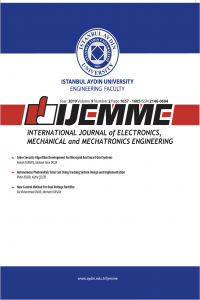A SURVEY on WIRELESS MESH NETWORKS, ROUTING METRICS and PROTOCOLS
A SURVEY on WIRELESS MESH NETWORKS, ROUTING METRICS and PROTOCOLS
Wireless Mesh Networks (WMN) routing metrics, protocols,
___
- Elizabeth M. Royer, Chai-KeongToh, "A Review of Current Routing Protocols for Ad Hoc Mobile Wireless Networks", IEEE Personal Communications, April, 1999.
- W. Zhang, Z. Wang, S. K. Das, and M. Hassan, “Security Issues in Wireless Mesh Networks,” In Book Wireless Mesh Networks: Architectures and protocols. New York: Springer, 2008.
- AKYILDIZ I.F., WANG X., 2009, Wireless
- Mesh Networks, WILEY, United Kingdom, 978-0- 032565.
- METHLEY S., 2009, Essentials of Wireless
- Mesh Networking, CAMBRIDGE, New York, 0-511-58070-3
- M.S.Aswall, Paramjeet Rawat, Tarun Kumar, “Threats and Vulnerabilities in Wireless Mesh Networks”, International Journal of Recent Trends in Engineering, Vol 2, No. 4, November 2009.
- Mihail L. Sichitiu, “Wireless Mesh Networks: Opportunities and Challenges”, Wireless World Congress, May 2005.
- Philip Whitehead, “Mesh Networks; a new Architecture for Broadband Wireless Access Systems”, Conference,September, 2000.
- Eng Chun; Lv Qin, LiuYong, Shi MeiLin, “Routing Protocols Overview and Design Issues for Self- Technology Proceedings, 2000. WCC - ICCT 2000, August, 2000.
- John Bellardo and Stefan Savage. “802.11 Denial of- Service Attacks: Real Vulnerabilities and Practical Solutions”. In Proceedings of the USENIX Security Symposium, pages 15–27, August 2003.
- S. Waharte, B. Ishibashi, R. Boutaba, “Performance Study of Wireless Mesh Networks Routing Metrics”, Computer Systems and Applications, April, 2008.
- K. Rayner. Mesh wireless networking. Communications Engineer, 1(5):4447,Oct.-Nov.
- H.-Y. Wei, S. Ganguly, R. Izmailov, and Z. Haas. Interference-aware IEEE 802.16 WiMax mesh networks. In Proceedings of the IEEE Vehicular Technology Conference (VTC), 2004.
- D. De Couto, D. Aguayo, J. Bicket, and R. Morris. A high-throughput path metric for multi- hop wireless routing.In Proceedings of the 9th Annual International Conference on Mobile Computing and Networking (MobiCom), 2003.
- R. Draves, J. Padhye, and B. Zill.Comparison of routing metrics for static multi-hop wireless networks.In Proceedings of the 2004 conference on
- Applications, technologies, architectures, and protocols for computer communications (SIGCOMM), August 2004.
- Y. Yang, J. Wang, and R. Kravets.Designing routingmetrics for mesh networks. In Proceedings of the 1st IEEE Workshop on Wireless Mesh Networks (WiMesh),2005.
- C.E. Koskal and H. Balakrishnan. Quality- aware routing metrics for time-varying wireless mesh networks. IEEE Journal on Selected Areas in Communications, 24(11):1984-1994, November
- Miguel Elias M. Campista, Pedro Miguel Esposito, Igor M. Moraes, Luís Henrique M. K. Costa, Otto Carlos, Diego G. Passos, CélioVinicius N. de Albuquerque, Débora Christina M. Saade, Marcelo G. Rubinstein, “Routing Metrics and Protocols for Wireless Mesh Networks”, IEEE Network,2008.
- R. Draves, J. Padhye, and B. Zill, “Routing in Multi-Radio, Multi-Hop Wireless Mesh Networks,” ACM MobiCom, Sept. 2004, pp. 114–28.
- D. S. J. de Couto, “High-Throughput Routing for Multi-Hop Wireless Networks,” Ph.D. diss., MIT, 2004.
- S. Nelakuditi et al., “Blacklist-Aided Forwarding in Static Multihop Wireless Networks,” IEEE SECON ’05, Sept. 2005, pp. 252–62.
- K. N. Ramachandran et al., “On the Design and Implementation of Infrastructure Mesh Networks,” IEEE Wksp. Wireless Mesh Networks, Sept. 2005.
- A. Raniwala and T.-C.Chiueh, “Architecture and Algorithms for an IEEE 802.11-Based Multi- Channel Wireless Mesh Network,” IEEE INFOCOM, Mar. 2005, pp. 2223–34.
- S. Biswas and R. Morris, “ExOR : Opportunistic Multi-Hop Routing for Wireless Networks,” ACM SIGCOMM, Aug. 2005, pp. 133–
- Y. Yuan et al., “ROMER: Resilient Opportunistic Mesh Routing for Wireless Mesh Networks,” IEEE Wksp. Wireless Mesh Networks, Sept. 2005.
- ISSN: 2146-0604
- Başlangıç: 2011
- Yayıncı: İstanbul Aydın Üniversitesi
Pelin GÖRGEL, Ahmet SERTBAS, Osman Nuri UCAN
A SURVEY on WIRELESS MESH NETWORKS, ROUTING METRICS and PROTOCOLS
Safak DURUKAN ODABASI, A. Halim ZAIM
ENGLISH PREPARATORY PROGRAM INFORMATION SYSTEM
Metin ZONTUL, Oğuz KAYNAR, Mustafa Kırgül
CONDITION SURVEY OF HISTORIC BUILDINGS BY VISUAL INSPECTION - CASE STUDY: MURAT PASHA MOSQUE
PROGRAMMABLE METRONOME FOR PERCUSSION INSTRUMENTS AND AN APPLICATION
DETERMINATION OF VEHICLE COMPONENTS FATIGUE LIFE BASED ON FEA METHOD AND EXPERIMENTAL ANALYSIS
Roger Lédée, Fabien Courrèges, Rachid Harba, Onur Osman, Osman N. Ucan
BREAST CANCER CLASSIFICATION WITH GENETIC PROGRAMMING
EFFECTS OF HIGH ECONOMIC IMPORTANCE OF INDUSTRIAL BRANCHES ON HUMAN LIFE QUALITY AND ENVIRONMENT
Doguş Deniz Özarslan, Melek Cumbul Altay, Aliye Arabaci, H. Fatih Altay, Nüket Sivri
